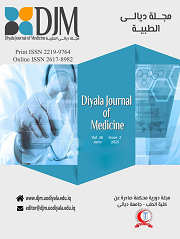Type 3 Secretion System Virulotypes in Clinical Isolates of Multidrug Resistant Pseudomonas aeruginosa
Main Article Content
Abstract
Background: Multidrug-resistant Pseudomonas aeruginosa has epidemiological impact on human health. It poses a threat to the health systems of the world including Iraq. Type 3 Secretion System effectors are among the several virulence factors that this bacterium possess. Determining the virulence profile is essential in prevention of infection. This study investigates the frequency of the four classical Type 3 Secretion System effectors in multidrug resistant Pseudomonas aeruginosa.
Patients and Methods: This study initially included 120 bacterial isolates from different clinical samples which were preliminary identified as P. aeruginosa. Out of those, 80 isolates were confirmed to be P. aeruginosa. Antibiotic susceptibility profile was studied and the existence of exoY, exoT, exoS and exoU was investigated by PCR.
Results: 95%, 3.75%, and 1.25% of the isolates were classified as multidrug resistant, extensive drug resistant, and pan drug resistant, respectively. Among the selected isolates, exoT was found in 86.7%, exoY in 76.7%, exoS in 50% and, exoU in 30%.
Conclusion: This study highlights an increase in the emergence of multidrug resistant profiles in clinical isolates of P. aeruginosa, besides the co-existence of the four classical Type 3 Secretion System effectors in variable frequencies (86.7%, 76.7%, 50%, and 30%, respectively).
Keywords: P. aeruginosa, Clinical isolates, T3SS, MDR.
Downloads
Article Details

This work is licensed under a Creative Commons Attribution 4.0 International License.





